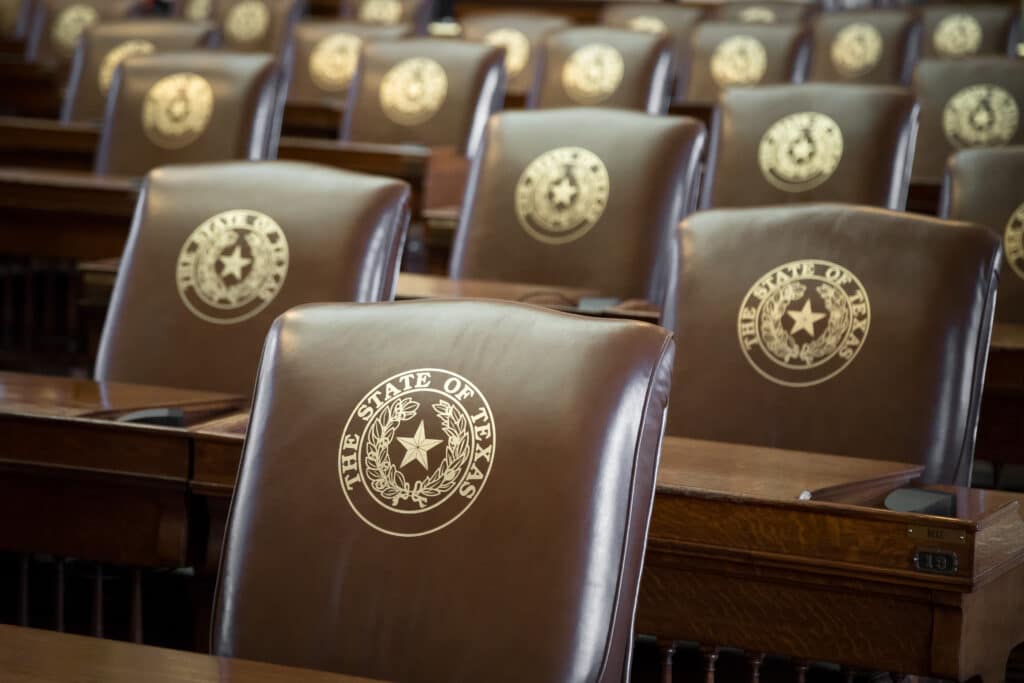Everything Is Bigger in Texas—Including the Budget

Texas flag American dollar
The old adage “everything is bigger in Texas” has recently taken on new meaning. Add the state budget to the list.
While a pandemic brought the global economy to a crawl, Texas not only held its own but advanced its reputation as a top spot for business relocations and expansions. State leaders, experts, and executives cite factors that long have made Texas an attractive choice: its business-friendly tax and regulatory environment, location, workforce, quality of life, and relatively low cost of living.
Now, funds from the American Rescue Plan Act (ARPA) could add fuel to already fired-up Texas economy. The relief package, passed by Congress and allocated by the 87th Texas Legislature in special session last year, included $13.3 billion for projects to help Texas keep up with population growth and prepare for the future. The 88th Legislature will have another $3 billion to spend, which must be allocated by December 31, 2024, and spent by the end of 2026.

At the same time, Texas continues to be a magnet for business relocations and expansions.
Chief Executive’s survey of CEOs for the magazine’s ranking of Best and Worst States for Business 2021 found 44 percent were “more open than before to examining new locations.” It continues to note that “in a world of remote work, reshuffled markets, and flat-out rethinking of nearly every aspect of business, the hearts and minds of CEOs are very much up for grabs.”
In 2022, Texas again ranked first as a Best State for Business, a position it has held every time Chief Executive has done the list since 2001. Texas’ efforts to attract business have paid off in a big way for the past several years. High-profile announcements include these:
- Caterpillar recently announced a re-location of its corporate headquarters to Irving, Texas after more than a century in Illinois and bring most of their 230 C-suite executives with them.
- Tesla chose the Austin area for its Gigafactory and its headquarters relocation.
- Hewlett Packard Enterprise moved its headquarters to Spring, just north of Houston.
- Oracle moved its headquarters to Austin.
- Texas Instruments announced a potential $30 billion project in Sherman, including up to four chip fabrication plants.
- Amazon is also expanding. The company has invested more than $29 billion across the state since 2010, including infrastructure and compensation to employees.
- Samsung announced a new semiconductor manufacturing facility in Taylor, in the Austin area.
Governor Greg Abbott said that Texas now leads the nation in Fortune 500 corporate headquarters, with 54, and that 250 companies have moved corporate headquarters to Texas since 2015.
Caterpillar, which posted $51 billion in revenue last year, will become the fifth-largest public company headquartered in North Texas, along with Exxon Mobil, McKesson, AT&T and Energy Transfer Partners.
The $17 billion announcement by Samsung was described as the largest-ever foreign direct investment in Texas; Governor Greg Abbott’s office in November said the project would bring the South Korean company’s investment in the state to more than $35 billion since 1996. The incentive package that helped land the Taylor deal, including property tax abatements, totaled $981 million, according to an analysis by the Austin American-Statesman.
Samsung cited factors like the local semiconductor ecosystem, infrastructure stability, local government support, and community development opportunities, as well as the Taylor site’s proximity to the company’s existing Austin facilities, as key factors in their decision.
Economic development incentives are valuable tools in the global competitive landscape. With the Texas budget surplus expected to reach as much as $30 billion when the 88th Legislature convenes in January 2023, it’s clear that Texas can put together economic development incentives to land even more opportunities.
Access to talent and skilled labor is a key factor for most (if not all) companies looking to invest. Texas tech hubs—particularly in Austin, Houston and Dallas—provide more space to create good jobs in communities with an abundance of amenities, a high quality of life, and a deep talent pool from which to draw.
A move to give employees more choices in the workplace—such as telework, which became more common during the worst of the COVID-19 pandemic—came into play for some companies. Hewlett Packard Enterprise, for example, offered relocation to Texas as an option for several hundred headquarters staff members, but staffers had the choice of staying in California.
Texas’ ability to attract business is helping fuel its overall population increase as the state heads toward 30 million residents. The US Census Bureau’s population estimates show the state at 29.5 million in 2021, with 310,288 people added between July 1, 2020, and July 1, 2021. Net migration was 63.6 percent of that increase, according to the Texas Demographic Center.

As states began to allocate funds from ARPA, Texas policymakers passed Senate Bill 8 (SB 8) in 2021. Highlights of the funding package include:
- $7.2 billion for the Unemployment Compensation Fund
- $650.5 million for broadband and emergency communications
- $467.2 million for education and workforce
- $226.2 million for IT and cybersecurity
While increased funding is important, being able to track outcomes tied to funding increases is smart policy. SB 8 requires the Legislative Budget Board, in consultation with the comptroller, to publicly report on a quarterly basis how federal funds appropriated under SB 8 were spent through 2028.
But there is even more funding coming Texas’ way.
ARPA created the Coronavirus Capital Projects Fund, which includes $10 billion that states can seek in order to invest in capital assets that enable work, education, and health monitoring, including remote options, and to address critical community needs made apparent by the COVID-19 public health emergency. This can include broadband infrastructure projects, digital connectivity technology projects, and improvements to connectivity, device, and digital literacy at “multi-purpose community facilities.” The 87th Legislature appropriated $500.5 million from this Coronavirus Capital Projects Fund for use in Texas.
Meanwhile, the Coronavirus State and Local Fiscal Recovery Fund will provide $350 billion for projects intended to combat the pandemic’s economic fallout and lay the foundation for a strong recovery. Eligible state, local, territorial, and tribal governments have significant flexibility in determining how to allocate the funds based on local needs; among the eligible uses are “necessary investments in water, sewer, or broadband infrastructure.” Texas’ allocation from this fund is $12.8 billion.
This funding is separate from the recently enacted Infrastructure Investment and Jobs Act, which will provide an additional $65 billion to help policymakers address high-speed Internet access and adoption.
With the pandemic driving home the critical importance of high-speed Internet, states—including Texas—across the country are using ARPA money to expand broadband access and affordability. Appropriators have increased funds for infrastructure deployment grants, and some have used Capital Projects Fund or State and Local Fiscal Recovery Fund allocations to pay for specific projects related to mapping, education, and public health.
State leaders are also focused on enhancing and protecting pandemic-battered supply chains, such as those providing chips that are essential to products from computers to cars. Decisions by large employers to place chip-manufacturing facilities in Texas are in alignment with this focus.
With a little help from our friends in Washington, Texas is poised to forge an even stronger economy—one that includes knowledge jobs, technological advancements, and innovations that will improve the quality of life for millions of Texans and beyond.





Texas Economic Indicators: From the Federal Reserve...
June 2, 2022